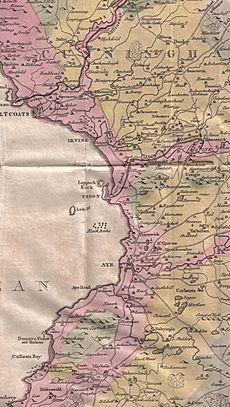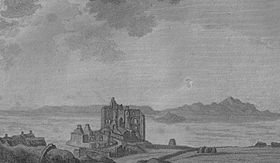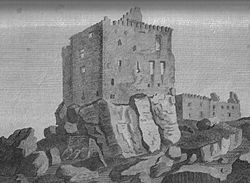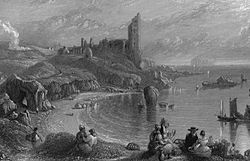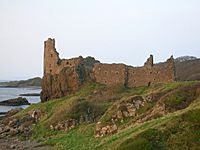Dunure Castle facts for kids
Quick facts for kids Dunure Castle |
|
|---|---|
| 5 miles from Ayr, Scotland |
|
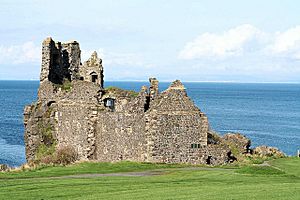
Dunure Castle from the east
|
|
| Site information | |
| Owner | Private |
| Open to the public |
Yes |
| Condition | Ruined |
| Site history | |
| Built | 13th century |
| Built by | Clan Kennedy |
| In use | 13th to 17th century |
| Materials | Stone |
Dunure Castle is an old castle located on the west coast of Scotland. It's in South Ayrshire, about 5 miles (8 km) south of Ayr, near the village of Dunure. Today, the castle is mostly in ruins. It stands on a rocky point overlooking the small harbour of Dunure.
Contents
Discovering Dunure Castle
The castle site has been around since the late 1200s. The first official document about the land is from 1256. However, most of the castle buildings you see today were built in the 1400s and 1500s. Some stories say the castle was built by the Danes. Another story suggests the Mackinnon family owned it. They supposedly got it from Alexander III of Scotland for being brave at the Battle of Largs.
Dunure Castle is the original home of the Clan Kennedy. This powerful family once controlled a large part of southwestern Scotland. They were given these lands in 1357. An old writer, Sir James Balfour, called Dunure "a great and pleasant strong house." He said it was the oldest home of the Kennedy family, who later became the Earls of Cassilis.
In August 1563, Mary, Queen of Scots, visited the castle. She stayed there for three days during her trip around the west of the country. The name Dunure comes from an old Celtic word. It means "hill" or "fort of the yew tree."
The Crossraguel Abbey Dispute
In 1570, a big disagreement happened. It was between Gilbert Kennedy, 4th Earl of Cassilis, and Allan Stewart. Allan was in charge of Crossraguel Abbey after the monks left. The fight was about who owned some of the abbey's lands and the money they made from rent. Gilbert's uncle, Quintin Kennedy, was the last true abbot of Crossraguel. Gilbert thought he would get control of the abbey. But Allan got it instead, thanks to his relative, Captain James Stewart of Cardonald.
Gilbert Kennedy, with sixteen of his men, found Allan Stewart in Crossraguel Woods. Allan was a guest of the Laird of Bargany. Gilbert tricked Allan into going to Dunure Castle. Once there, Allan was taken inside. His horse and weapons were taken away, and six of Gilbert's men guarded him.
For two days, Gilbert left Allan to think about his situation. Allan was stubborn and refused to sign over the lands and rent money. So, Gilbert used harsh methods to force him. After these difficult sessions, Allan finally signed over the lands to Gilbert in September 1570.
Allan Stewart was later rescued from the castle. The Laird of Bargany, Allan's brother-in-law, arrived with many men. They first hid in the chapel and then stormed the castle. The rights to the abbey lands were eventually settled. Gilbert gave Allan Stewart enough money to live comfortably for the rest of his life. Allan had spoken out against the Earl of Cassillis in public. The Earl was not fully punished for his actions by the Privy Council. Allan Stewart, however, suffered lasting effects and never walked again.
The castle and land of Dunure were later bought by Sir Thomas Kennedy of Kirkhill. This happened in the late 1600s.
How the Castle Was Used and Fell Apart
Dunure Castle had two main parts. There was a strong tower, called a keep, on top of a steep rock. Other buildings were at a lower level. The walls of the keep are about five feet thick. The arched rooms in the basement are still in good condition. But most of the upper parts are gone. The keep was the original castle, but it was changed a lot over time. The middle part of the castle might be from the 1400s. It was built to protect the entrance to the keep. The extra buildings were added later. They had two kitchens on the ground floor. One was for the castle residents, and the other for their servants.
To the northeast, there's a separate wall that might have led to a gate. A drawbridge might have been nearby. A chapel might have been built against the thick wall of the castle's central part. A ditch, called a moat, protected the entrance. There might have also been a wall around the castle.
In the 1990s, archaeologists dug up parts of the castle. They found that a large hall house was built in the 1300s. This was on top of a 1200s courtyard.
Beneath the castle, there is a secret cave called the Browney's Cave. This might have been a sally-port. A sally-port is a hidden tunnel that allowed people to secretly leave or enter the castle.
In 1429, an important meeting happened at Dunure. James Campbell represented King James I of Scotland. John Mor MacDonald represented the Lord of the Isles. A fight broke out, and MacDonald was killed. King James I tried to calm the anger of the Lords of the Isles by executing Campbell. But this did not stop a rebellion from them later on.
As mentioned, Mary, Queen of Scots, stayed at Dunure Castle for three days. This was from August 4, 1563. She was on her royal tour down the west coast. She visited places like Glenluce Abbey and Whithorn Priory. Gilbert Kennedy, the 4th Earl of Cassilis, was her host.
The Doocot
The castle also had a "beehive"-shaped dovecot. This is a special building for pigeons. It was probably built in the 1400s. It would have had about 200 nesting spots for pigeons. These pigeons would have provided fresh eggs and meat for the castle.
The Castle's Ruin
Dunure Castle started to fall apart in the mid-1600s. By 1694, it was described as "completely ruined." It's not clear if this was because of the Civil War. But local stories say Dunure was burned or blown up. A large part of the main tower collapsing could be linked to this. People also took building materials from Dunure. They used them to build a fort for Cromwell's army in Ayr. This also happened at Ardrossan Castle. There is much proof that the castle was taken apart on purpose. Things like slates, stones, and glass were carefully removed. The windows were taken apart, and their lead was stripped out. Signs of a fire and coal suggest that the lead was melted down inside the castle. The people taking the castle apart seemed to have lived in a part of it while they worked.
Later, people continued to take sandstone blocks from the ruins. Some castle buildings to the south remained lived in until about 1860. Census records show that some of the people living there were fishermen. A large pile of mussel shells was found. This shows they used mussels to bait their fishing lines. Other household trash from the late 1700s and early to mid-1800s was also found. The only military action recorded at Dunure was a short siege in 1570. It's also possible the castle was damaged during the Civil War. However, it might have already been empty by then. A stone-lined water channel was found near the south end of the castle. It ran into the entrance of the kitchen area. Another well-preserved part of this water channel was found further south.
Dunure Castle Today
The castle has been dug up and made safe. This allows people to visit the area. The castle is a main feature of Kennedy Park. The park has many things for visitors to enjoy. People also say there are secret Ley tunnels. These tunnels supposedly connect Dunure Castle to Greenan Castle, which is further north.
A Canadian billionaire named Brendan Clouston is the Baron of Dunure. This title was officially registered in 2009.
Micro-history
In a story called "The Brownie of Dunure," Sir Thomas Kennedy of Dunure takes in the son of his neighbor, Reginald Duff. Sir Thomas has a daughter who was born outside of marriage. He hopes his daughter and Reginald's son will marry. But the O'Neils from Ireland also want to marry his daughter. To make sure it's a love match, the legend of the Brownie of Dunure is used. The results are a mix of good and bad.
Images for kids


